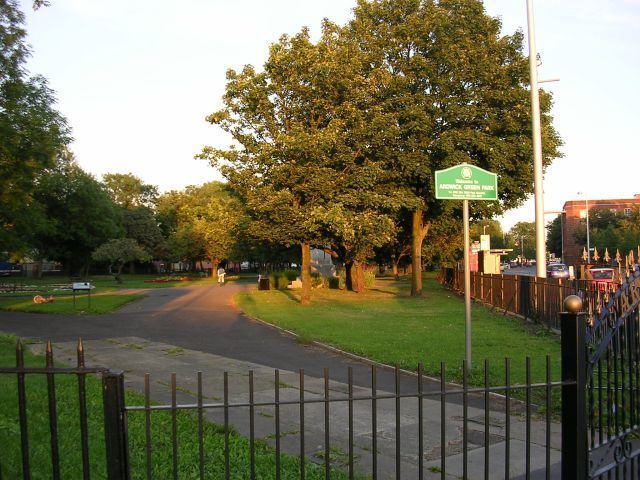OS grid reference SJ856975 Sovereign state United Kingdom Dialling code 0161 | ||
 | ||
Population 19,250 (2011 CensusWard) | ||
Ardwick green park manchester uk town centre
Ardwick is a district of Manchester in North West England, one mile south east of the city centre. The population of the Ardwick Ward was at the 2011 census 19,250.
Contents
- Ardwick green park manchester uk town centre
- Map of Ardwick Manchester UK
- History
- Industrial Revolution
- Civic history
- Political divisions
- Present day
- Demographics
- Notable people
- References
Map of Ardwick, Manchester, UK
Historically in Lancashire, by the mid-19th century Ardwick had grown from being a village into a pleasant and wealthy suburb of Manchester, but by the end of that century it had become heavily industrialised. When its industries later fell into decline then so did Ardwick itself, becoming one of the city's most deprived areas. Substantial development has taken place more recently in Ardwick and other areas of Manchester to reverse the decline, notably the construction of many facilities for the 2002 Commonwealth Games held nearby in Eastlands.
In the late 19th century Ardwick had many places of entertainment, but the only remnant of that history today is the Art Deco Manchester Apollo, a venue for pop and rock music concerts.
History
Prior to the Industrial Revolution, Ardwick was a small village situated just outside Manchester in open countryside. The principal residents were the Birch family, one of whom was a major general when Oliver Cromwell (briefly) instituted direct military rule.
One Samuel Birch was instrumental in providing a small chapel of ease, dedicated to St. Thomas, and consecrated in 1741. This soon expanded into a Georgian church, to which a brick campanile tower was added in the 1830s. It contained a very rare Samuel Green organ, the first in which the sharp keys were distinguished in black. There was also a memorial chapel to the dead of the First World War, chiefly men of the local territorial unit. These have been removed, and the church is now used as offices for voluntary organisations.
Grand terraces of regency houses (some of which still survive) were built either side of the church, and these were fronted by Ardwick Green, a private park for the residents, containing a pond. Similar housing developments to those around the Green took place along Higher Ardwick and the area known as the Polygon.
Early inhabitants included members the family of Sir Robert Peel. Charles Dickens drew many of his characters from life, and was a frequent visitor to Manchester. It is said that Dickens based the character of the crippled Tiny Tim in A Christmas Carol on the invalid son of a friend who owned a cotton mill in Ardwick.
Ardwick Cemetery was established in the 1830s as a prestigious place for fashionable burials. John Dalton, the chemist and physicist best known for his advocacy of atomic theory, is amongst those buried there. The cemetery has since been converted into a school playing field.
Industrial Revolution
During the 19th century, Ardwick became heavily industrialised and it was characterised by factories, railways and rows of back-to-back terraced houses being juxtaposed. Large numbers of Irish immigrants settled here, as they did throughout Manchester. Ardwick railway station is situated at a junction where the Manchester and Birmingham Railway, later the London and North Western Railway diverged from the line to Sheffield that became the Great Central Railway. Nicholls Hospital, a neo-gothic building that was later a school, was constructed on Hyde Road in the last quarter of the 19th century. More recently it has become the Nicholls Campus of the Manchester College.
The railway bridge across Hyde Road was known by older residents as the "Fenian Arch". On 18 September 1867 it was the scene of an attack upon a prison van carrying two Fenian prisoners to the former Belle Vue gaol (jail). One police officer was shot dead. Three Irishmen involved in the affray were caught, tried and executed. The men are referred to by their supporters as the "Manchester Martyrs".
Civic history
The village of Ardwick can be traced back to 1282, when it was known as Atherdwic and the road between Manchester and Stockport runs through it. From mediaeval times Ardwick was an independent township in the ancient parish of Manchester within the Salford hundred of Lancashire. It became part of the Borough of Manchester on the borough's creation in 1838. The historic boundary between Ardwick and Manchester was the River Medlock.
Political divisions
Ardwick ward is represented by three councillors, Tina Hewitson, Bernard Priest and Mavis Smitheman, all members of the Labour Party. Smitheman (2008–09) has served as Lord Mayor of Manchester.
Present day
Ardwick Green Park has recently been refurbished, and though the pond is no more, it still contains an interesting glacial erratic in the form of a boulder. There is also a cenotaph commemorating the 'Eighth Ardwicks', once a Territorial Army unit of the Manchester Regiment. Ardwick Green Barracks is a fine Victorian castellated structure bearing the old volunteer motto "Defence Not Defiance". It is still in military use today.
The Manchester Apollo, a 1930s Art Deco theatre, is one of Ardwick's most famous landmarks: it was in use as a cinema from 1943 and was renamed the ABC Ardwick in 1962. An independent operator took over in 1977 and staged pop concerts interspersed with the occasional film, until dropping films entirely. The venue now plays host to national and international performing artists.
Extensive demolition of dilapidated Victorian terraces took place around Ardwick during the 1960s. Some residents remained in the area in new council-owned houses and flats, while others were moved to overspill estates such as Hattersley.
Demographics
(According to 2011 census)
